High-level Plasmodium falciparum sulfadoxine-pyrimethamine resistance with the concomitant occurrence of septuple haplotype in Tanzania
- PMID: 26542942
- PMCID: PMC4635599
- DOI: 10.1186/s12936-015-0977-8
High-level Plasmodium falciparum sulfadoxine-pyrimethamine resistance with the concomitant occurrence of septuple haplotype in Tanzania
Abstract
Background: Tanzania abandoned sulfadoxine-pyrimethamine (SP) as the first-line treatment for uncomplicated malaria in 2006 due to high levels Plasmodium falciparum resistance. However, SP is still being used for intermittent preventive treatment during pregnancy (IPTp-SP). This study aimed to assess the pattern of P. falciparum dihydrofolate reductase (Pfdhfr) and dihydropteroate synthetase (Pfdhps) mutations and associated haplotypes in areas with different malaria transmission intensities in mainland Tanzania, 6 years after withdrawal of SP as a first-line treatment regimen for uncomplicated malaria.
Methods: A total of 264 samples were collected during cross-sectional surveys in three districts of Muheza, Muleba and Nachingwea in Tanga, Kagera and Lindi regions, respectively. Parasite genomic DNA was extracted from P. falciparum positive samples. The Pfdhfr, Pfdhps single nucleotide polymorphisms (SNPs) were amplified using nested polymerase chain reaction and detected by sequence specific oligonucleotide probe-enzyme linked immunosorbent assay (SSOP-ELISA).
Results: The prevalence of the mutant Pfdhfr-Pfdhps haplotypes was heterogenous and transmission dependent. The triple Pfdhfr mutant haplotypes (CIRNI) were predominant in all sites with significantly higher frequencies at Muheza (93.3 %) compared to Muleba (75.0 %) and Nachingwea districts (70.6 %), (p < 0.001). Overall, the prevalence of the wild-type Pfdhps (SAKAA) haplotype was lowest at Muheza (1.3 %), (p = 0.002). Double Pfdhps haplotype SGEAA was significantly high at Muheza (27.2 %) and Muleba (20.8 %) while none (0 %) was detected at Nachingwea (p < 0.001). The prevalence of triple Pfdhps SGEGA haplotype was significantly higher at Muheza compared to Muleba and Nachingwea (p < 0.001). In contrast, Nachingwea and Muleba had significantly higher prevalence of another triple Pfdhps AGEAA haplotype (χ(2) = 39.9, p < 0.001). Conversely, Pfdhfr-Pfdhps as quintuple and sextuple haplotypes were predominant including the emergence of a septuple mutant haplotype CIRNI-AGEGA (n = 11) observed at Muheza and Muleba.
Conclusion: These results ascertain the high prevalence and saturation of Pfdhfr and Pfdhps haplotypes conferring SP resistance in areas with changing malaria epidemiology; and this could undermine the use of IPTp-SP in improving pregnancy outcomes. In these settings where high level SP resistance is documented, additional control efforts are needed and evaluation of an alternative drug for IPTp is an urgent priority.
Figures
Similar articles
-
Occurrence of septuple and elevated Pfdhfr-Pfdhps quintuple mutations in a general population threatens the use of sulfadoxine-pyrimethamine for malaria prevention during pregnancy in eastern-coast of Tanzania.BMC Infect Dis. 2020 Jul 22;20(1):530. doi: 10.1186/s12879-020-05253-7. BMC Infect Dis. 2020. PMID: 32698764 Free PMC article.
-
High prevalence of Pfdhfr-Pfdhps quadruple mutations associated with sulfadoxine-pyrimethamine resistance in Plasmodium falciparum isolates from Bioko Island, Equatorial Guinea.Malar J. 2019 Mar 26;18(1):101. doi: 10.1186/s12936-019-2734-x. Malar J. 2019. PMID: 30914041 Free PMC article.
-
Increased prevalence of pfdhfr and pfdhps mutations associated with sulfadoxine-pyrimethamine resistance in Plasmodium falciparum isolates from Jazan Region, Southwestern Saudi Arabia: important implications for malaria treatment policy.Malar J. 2020 Dec 2;19(1):446. doi: 10.1186/s12936-020-03524-x. Malar J. 2020. PMID: 33267841 Free PMC article.
-
Evolution of Pfdhps and Pfdhfr mutations before and after adopting seasonal malaria chemoprevention in Nanoro, Burkina Faso.Sci Rep. 2024 Oct 16;14(1):24224. doi: 10.1038/s41598-024-75369-2. Sci Rep. 2024. PMID: 39414909 Free PMC article.
-
Origins and spread of pfdhfr mutant alleles in Plasmodium falciparum.Acta Trop. 2010 Jun;114(3):166-70. doi: 10.1016/j.actatropica.2009.07.008. Epub 2009 Jul 14. Acta Trop. 2010. PMID: 19607799 Review.
Cited by
-
The Effectiveness of the Revised Intermittent Preventive Treatment with Sulphadoxine Pyrimethamine (IPTp-SP) in the Prevention of Malaria among Pregnant Women in Northern Ghana.J Trop Med. 2020 Nov 23;2020:2325304. doi: 10.1155/2020/2325304. eCollection 2020. J Trop Med. 2020. PMID: 33299426 Free PMC article.
-
Molecular surveillance of anti-malarial resistance Pfdhfr and Pfdhps polymorphisms in African and Southeast Asia Plasmodium falciparum imported parasites to Wuhan, China.Malar J. 2020 Nov 25;19(1):434. doi: 10.1186/s12936-020-03509-w. Malar J. 2020. PMID: 33238987 Free PMC article.
-
Prevalence and Correlates of Asymptomatic Malaria and Anemia on First Antenatal Care Visit among Pregnant Women in Southeast, Tanzania.Int J Environ Res Public Health. 2020 Apr 30;17(9):3123. doi: 10.3390/ijerph17093123. Int J Environ Res Public Health. 2020. PMID: 32365839 Free PMC article.
-
Molecular surveillance of Plasmodium falciparum drug resistance markers reveals partial recovery of chloroquine susceptibility but sustained sulfadoxine-pyrimethamine resistance at two sites of different malaria transmission intensities in Rwanda.Acta Trop. 2016 Dec;164:329-336. doi: 10.1016/j.actatropica.2016.09.008. Epub 2016 Sep 17. Acta Trop. 2016. PMID: 27647575 Free PMC article.
-
Pharmacokinetics of piperaquine and its association with intermittent malaria preventive therapy outcomes during pregnancy.BMC Pharmacol Toxicol. 2024 Jul 8;25(1):38. doi: 10.1186/s40360-024-00762-6. BMC Pharmacol Toxicol. 2024. PMID: 38978151 Free PMC article.
References
-
- Mugittu K, Abdulla S, Falk N, Masanja H, Felger I, Mshinda H, et al. Efficacy of sulfadoxine-pyrimethamine in Tanzania after two years as first-line drug for uncomplicated malaria: assessment protocol and implication for treatment policy strategies. Malar J. 2005;4:55. doi: 10.1186/1475-2875-4-55. - DOI - PMC - PubMed
Publication types
MeSH terms
Substances
Grants and funding
LinkOut - more resources
Full Text Sources
Other Literature Sources


